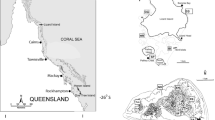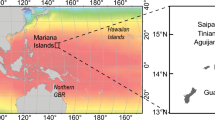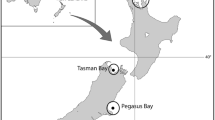Abstract
This study took advantage of a unique opportunity to collect large sample sizes of a coral reef fish species across a range of physical and biological features of the Hawaiian Archipelago to investigate variability in the demography of an invasive predatory coral reef fish, Cephalopholis argus (Family: Epinephelidae). Age-based demographic analyses were conducted at 10 locations in the main Hawaiian Islands and estimates of weight-at-length, size-at-age, and longevity were compared among locations. Each metric differed among locations, although patterns were not consistent across metrics. Length-weight relationships for C. argus differed among locations and individuals weighed less at a given length at Hilo, the southernmost location studied. Longevity differed among and within islands and was greater at locations on Maui and Hawaii compared to the more northern locations on Oahu and Kauai. Within-island growth patterns differed at Kauai, Oahu, and Hawaii. This work provides a case study of fundamental life history information from distant and/or spatially limited locations that are critical for developing robust fishery models. The differences observed both among and within islands indicate that variability may be driven by cross-scale mechanisms that need to be considered in fisheries stock assessments and ecosystem-based management.








Similar content being viewed by others
References
Akaike H (1981) Likelihood of a model and information criteria. J Econom 16(1):3–14
Beets J, Hixon MA (1994) Distribution, persistence, and growth of groupers (Pisces, Serranidae) on artificial and natural patch reefs in the Virgin-Islands. Bull Mar Sci 55(2–3):470–483
Berumen ML (2005) The importance of juveniles in modelling growth: butterflyfish at Lizard Island. Environ Biol Fish 72(4):409–413. doi:10.1007/s10641-004-2595-0
Beverton R, Holt S (1957) On the dynamics of exploited fish populations. Chapman & Hall, London
Bolker BM (2008) Ecological models and data in R. Princeton University Press, Princeton
Caselle JE (2011) Geographic variation in density, demography, and life history traits of a harvested, sex-changing, temperate reef fish. Can J Fish Aquat Sci 68:288–303
Caselle JE, Warner RR (1996) Variability in recruitment of coral reef fishes: the importance of habitat at two spatial scales. Ecology 77(8):2488–2504. doi:10.2307/2265748
Choat JH, Axe LM (1996) Growth and longevity in acanthurid fishes an analysis of otolith increments. Mar Ecol Prog Ser 134(1–3):15–26
Choat JH, Robertson DR (2002) Age-based studies. In: Sale PF (ed) Coral reef fishes: dynamics and diversity in a complex ecosystem. Elsevier, San Diego, CA, pp 57–80
Choat JH, Robertson DR, Ackerman JL, Posada JM (2003) An age-based demographic analysis of the Caribbean stoplight parrotfish Sparisoma viride. Mar Ecol Prog Ser 246:265–277
Cope JM, Punt AE (2009) Drawing the lines: resolving fishery management units with simple fisheries data. Can J Fish Aquat Sci 66(8):1256–1273. doi:10.1139/f09-084
Cowen RK, Paris CB, Srinivasan A (2006) Scaling of connectivity in marine populations. Science 311(5760):522–527. doi:10.1126/science.1122039
DeMartini EE, Friedlander AM, Sandin SA, Sala E (2008) Differences in fish-assemblage structure between fished and unfished atolls in the northern Line Islands, central Pacific. Mar Ecol Prog Ser 365:199–215. doi:10.3354/meps07501
DeMartini EE, Everson AR, Nichols RS (2011) Estimates of body sizes at maturation and at sex change, and the spawning seasonality and sex ratio of the endemic Hawaiian grouper (Hyporthodus quernus, F. Epinephelidae). Fish Bull 109(1):123–134
Dierking J, Williams ID, Walsh WJ (2009) Diet composition and prey selection of the introduced grouper species peacock hind (Cephalopholis argus) in Hawaii. Fish Bull 107(4):464–476
Fowler AJ (2009) Age in years from otoliths of adult tropical fish. In: Green BS, Mapstone BD, Carlos G, Begg GA (eds) Tropical fish otoliths: information for assesment, management, and ecology. Reviews: methods and technologies in fish biology and fisheries, vol 11. Springer, New York
Francis R (1988) Maximum-likelihood estimate of growth and growth variability from tagging data. N Z J Mar Freshw Res 22(1):43–51
Friedlander AM, Parrish JD (1998) Habitat characteristics affecting fish assemblages on a Hawaiian coral reef. J Exp Mar Biol Ecol 224(1):1–30. doi:10.1016/s0022-0981(97)00164-0
Friedlander AM, Brown EK, Jokiel PL, Smith WR, Rodgers KS (2003) Effects of habitat, wave exposure, and marine protected area status on coral reef fish assemblages in the Hawaiian archipelago. Coral Reefs 22(3):291–305. doi:10.1007/s00338-003-0317-2
Friedlander AM, Brown E, Monaco ME (2007) Defining reef fish habitat utilization patterns in Hawaii: comparisons between marine protected areas and areas open to fishing. Mar Ecol Prog Ser 351:221–233. doi:10.3354/meps07112
Friedlander AM, Aeby G, Brainard R, Brown E, Chaston K, Clark A, McGowan P, Montgomery T, Walsh WJ, Williams ID, Wiltse W (2008) The state of coral reef ecosystems of the main Hawaiian Islands. The state of coral reef ecosystems of the United States and Pacific Freely Associated States: 2008, vol NOS NCCOS 73. NOAA Technical Memorandum, Silver Spring
Friedlander AM, Wedding LM, Brown E, Monaco ME (2010) Monitoring Hawaii’s marine protected areas: examining spatial and temporal trends using a seascape approach (trans: Branch PbtNCfCMaAB). vol NOS NCCOS 117. NOAA Technical Memorandum, Silver Spring, MD
Grigg RW (1998) Holocene coral reef accretion in Hawaii: a function of wave exposure and sea level history. Coral Reefs 17(3):263–272. doi:10.1007/s003380050127
Gust N, Choat JH, Ackerman JL (2002) Demographic plasticity in tropical reef fishes. Mar Biol 140(5):1039–1051. doi:10.1007/s00227-001-0773-6
Jennings S, Kaiser MJ, Reynolds JD (2001) Marine fisheries ecology. Blackwell, Oxford
Kimura DK (1980) Likelihood methods for the von Bertalanffy growth curve. Fish Bull 77(4):765–776
Kritzer JP, Davies CR (2005) Demographic variation within spatially structured reef fish populations: when are larger-bodied subpopulations more important? Ecol Model 182(1):49–65. doi:10.1016/j.ecolmodel.2004.07.010
Kritzer JP, Sale PF (2004) Metapopulation ecology in the sea: from Levins’ model to marine ecology and fisheries science. Fish Fish 5(2):131–140
Kritzer JP, Davies CR, Mapstone BD (2001) Characterizing fish populations: effects of sample size and population structure on the precision of demographic parameter estimates. Can J Fish Aquat Sci 58(8):1557–1568
Manickchand-Heileman SC, Phillip DAT (2000) Age and growth of the yellowedge grouper, Epinephelus flavolimbatus, and the yellowmouth grouper, Mycteroperca interstitialis, off Trinidad and Tobago. Fish Bull 98(2):290–298
Meekan MG, Ackerman JL, Wellington GM (2001) Demography and age structures of coral reef damselfishes in the tropical eastern Pacific Ocean. Mar Ecol Prog Ser 212:223–232
Meyer AL, Dierking J (2011) Elevated size and body condition and altered feeding ecology of the grouper Cephalopholis argus in non-native habitats. Mar Ecol Prog Ser 439:203–212
Palumbi SR (2004) Marine reserves and ocean neighborhoods: the spatial scale of marine populations and their management. Annu Rev Environ Resour 29:31–68. doi:10.1146/annurev.energy.29.062403.102254
Pears RJ (2005) Comparative demography and assemblage structure of serranid fishes: implications for conservation and fisheries management. Dissertation, James Cook University, Townsville
Pittman SJ, Brown KA (2011) Multi-scale approach for predicting fish species distributions across coral reef seascapes. PLoS One 6(5). doi:e2058310.1371/journal.pone.0020583
Polovina JJ, Ralston S (1986) Tropical snappers and groupers: biology and fisheries management. Westview Press, Boulder
Porch CE, Wilson CA, Nieland DL (2002) A new growth model for red drum (Sciaenops ocellatus) that accommodates seasonal and ontogenic changes in growth rates. Fish Bull 100(1):149–152
R Development Core Team (2009) R: a language and environment for statistical computing. R Foundation for Statistical Computing, Vienna, Austria. http://www.R-project.org
Randall JE (1987) Introductions of marine fishes to the Hawaiian Islands. Bull Mar Sci 41(2):490–502
Randall JE (1996) Shore fishes of Hawai’i, vol 1. University of Hawaii Press, Honolulu
Ricker W (1975) Computation and interpretation of biological statistics of fish populations. Bull Fish Res Board Can 191:1–382
Robertson DR, Ackerman JL, Choat JH, Posada JM, Pitt J (2005) Ocean surgeonfish Acanthurus bahianus. I. The geography of demography. Mar Ecol Prog Ser 295:229–244
Ross SW, Moser ML (1995) Life-history of juvenile gag, Mycteroperca microlepis, in North Carolina estuaries. Bull Mar Sci 56(1):222–237
Ruttenberg BI, Haupt AJ, Chiriboga AI, Warner RR (2005) Patterns, causes and consequences of regional variation in the ecology and life history of a reef fish. Oecologia 145(3):394–403. doi:10.1007/s00442-005-0150-0
Sale PF (1998) Appropriate spatial scales for studies of reef-fish ecology. Aust J Ecol 23(3):202–208
Sale PF (2002) Coral reef fishes: dynamics and diversity in a complex ecosystem. Elsevier, San Diego, CA
Taylor BM, McIlwain JL (2010) Beyond abundance and biomass: effects of marine protected areas on the demography of a highly exploited reef fish. Mar Ecol Prog Ser 411:243–258. doi:10.3354/meps08672
Trip EL, Choat JH, Wilson DT, Robertson DR (2008) Inter-oceanic analysis of demographic variation in a widely distributed Indo-Pacific coral reef fish. Mar Ecol Prog Ser 373:97–109. doi:10.3354/meps07755
Williams AJ, Davies CR, Mapstone BD, Russ GR (2003) Scales of spatial variation in demography of a large coral-reef fish—an exception to the typical model? Fish Bull 101(3):673–683
Acknowledgments
This project was made possible by the many fishers throughout Hawaii who have caught roi over the years. Funding was provided by NOAA’s Coral Reef Conservation Program and the Hawaii Cooperative Fisheries Research Unit. We thank B. Wolfe, V. Scarborough, S. Ciarcia, N. Torkelson, E. Richards, T. Wooton, B. Roehl, H. Koike, P. Usseglio, K. Stamoulis, E. Schemmel, I. Iglesias, and H. Holt who assisted with data collection. Chad Wiggens, J. Giddens and M. Ramsey were instrumental in forming collaborations and obtaining samples. This project was in collaboration with P. Bienfang and S. Defelice of the Pacific Research Center for Marine Biomedicine who were funded by National Science Foundation grants OCE08-52301 and OCE11-29199.
Author information
Authors and Affiliations
Corresponding author
Rights and permissions
About this article
Cite this article
Donovan, M.K., Friedlander, A.M., DeMartini, E.E. et al. Demographic patterns in the peacock grouper (Cephalopholis argus), an introduced Hawaiian reef fish. Environ Biol Fish 96, 981–994 (2013). https://doi.org/10.1007/s10641-012-0095-1
Received:
Accepted:
Published:
Issue Date:
DOI: https://doi.org/10.1007/s10641-012-0095-1




